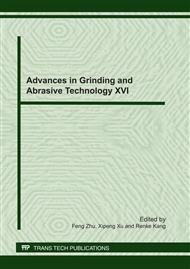p.195
p.199
p.204
p.209
p.215
p.220
p.225
p.229
p.233
Recovery of Electroplated Diamond Tool with Thermal Shock Method
Abstract:
When diamond abrasive layer becomes thinner, remaining expensive diamond grits will lose their cutting ability. The recovery of waste diamond tools can realize the recycling of material, is one kind of green manufacturing. Taken electroplated diamond tools for example, key technical problems for diamond tool recovery were discussed in this study. A thermal shock method was proposed for electroplated diamond tools recycling processes. Based on heat elastic-plastic theory, the stress state between abrasive layer and substrate of electroplated diamond tools was analyzed. Thermal shock processes of electroplated diamond tools were simulated with finite element method. Thermal shock experiments of electroplated diamond tools were carried out with experimental electric furnace. The results indicate that there exists stress variation between abrasive layer and tool substrate interface during thermal shock operation. The stress change will result in the interface cracking and the peeling of abrasive layers from substrate. There exists obvious stress gradient between abrasive layer and substrate interface. The stress extreme value occurs on the area of abrasive layer transition region, the corner or end of abrasive layer. Experimental results prove that the separating of abrasive layer and the tool substrate using thermal shock method is feasible.
Info:
Periodical:
Pages:
215-219
Citation:
Online since:
July 2011
Authors:
Keywords:
Price:
Сopyright:
© 2011 Trans Tech Publications Ltd. All Rights Reserved
Share:
Citation:


